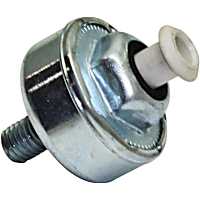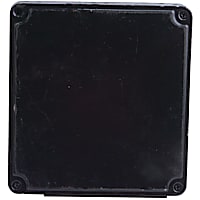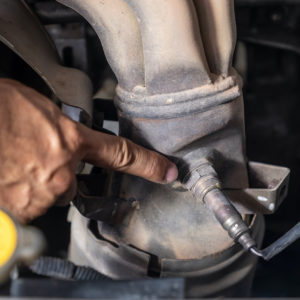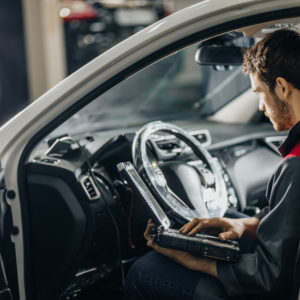If you’re struggling to figure out why your car has a logged P0326 error code, here’s some information to help point you in the right direction.
What Does the P0326 Code Mean?
Diagnostic trouble code (DTC) P0326 stands for “Knock Sensor 1 Circuit Range/Performance Bank 1.” It is set once the powertrain control module (PCM) determines that the signal from the knock sensor has fallen outside of the specified range. It may also be logged if the PCM fails to detect a signal from the knock sensor.

Knocking refers to the unwanted vibration and noise that could damage an engine. This is typically the result of fuel with too low of an octane rating, overly advanced ignition timing, or extreme engine operating temperatures. The PCM may also perceive an internal engine problem, such as a failed rod bearing, as engine knocking.
A knock sensor is a one-wire or two-wire sensor mounted on a cylinder block, and it detects engine knocking. “Knock sensor 1” in this code refers to the first sensor (if there are two), while “bank 1” refers to the side of the engine with cylinder #1.
The knock sensor detects vibration when revolutions per minute (RPM) rises or drops and generates voltages based on this vibration. The PCM controls the ignition timing based on the frequency of the sensor’s signal. If engine knocking occurs, the ignition timing slows down to prevent it.
Most PCMs can learn to distinguish spark knock trends in the engine during normal operation. The later ECM/PCM knock sensor algorithms can differentiate between detonation / spark knock and other engine knocking noises because they only register engine knocks during the narrow window of time for each cylinder. Knocking that doesn’t happen in one of the engine’s cylinder “time windows” isn’t counted as an engine knock on more sophisticated systems.
If the PCM perceives the knock to be severe enough that a retarded spark timing can’t eliminate it, it will set code P0326. It will also log the code if it determines the knocks to be louder and higher than the set threshold.
Read our technical explanation about what knock sensors do to find more information that can help you fully understand P0326.

Note: The definition of code P0326 may be different depending on the vehicle manufacturer. Consult the appropriate repair manual or repair database for the exact code definition.
What are the Possible Causes of the P0326 Code?
P0326 is a generic code, so it can have several causes. Here are the most common:
- Defective knock sensor
- Wiring issue
- Internal engine problem
- Faulty PCM
What are the Common Symptoms of the P0326 Code?
You may notice the following symptoms if your car has a logged P0326:
- Illuminated check engine light
- Odd noise coming from the engine
How to Diagnose the P0326 Code
Diagnosing code P0326 can be hard because it shares similar triggers and symptoms with other DTCs. However, despite being a generic code, it does not have a universal fix. Vehicles are built differently depending on the manufacturer, so diagnostic procedures may vary.
For example, the diagnosis for a code P0326 on a Hyundai may differ from the same logged code on a Toyota. Err on the side of caution by referring only to repair and diagnostic information specific to your vehicle. Leave the diagnosis to a technician if you’re not confident in your automotive knowledge.

How to Fix the P0326 Code
Code P0326 may be set in vehicles of varying makes and models. However, there is no universal solution for this code. All cars are built differently and may require varying solutions.
Always refer to the factory repair information specific to your vehicle before starting on any repairs. You can also opt to bring your car to an auto repair shop if you’re still unsure of which appropriate repair steps to follow.
Get a Replacement Knock Sensor Without Leaving Home
While it’s essential to replace the faulty parts triggering DTC P0326, it can be a chore. A defective knock sensor is likely causing the odd noises coming from your engine, and finding a new one means going to the store, asking which sensors fit your vehicle, and more. To avoid the hassle, check out CarParts.com.
The CarParts.com website is convenient and easy to navigate. Input your vehicle’s make and model into our built-in vehicle selector to quickly browse various parts on display. We guarantee that any parts you view will fit your vehicle perfectly. If anything’s wrong, it’s easy to return any rare defective parts with our 60-day return policy. You don’t have to wait long after checking out either. We’ll ship your parts straight to your door in as fast two business days.
Rid yourself of odd noises coming from your engine. Get a replacement knock sensor at CarParts.com now.
Products Mentioned in this Guide
Any information provided on this Website is for informational purposes only and is not intended to replace consultation with a professional mechanic. The accuracy and timeliness of the information may change from the time of publication.


 Knock Sensor
Knock Sensor
 Engine Control Module
Engine Control Module















